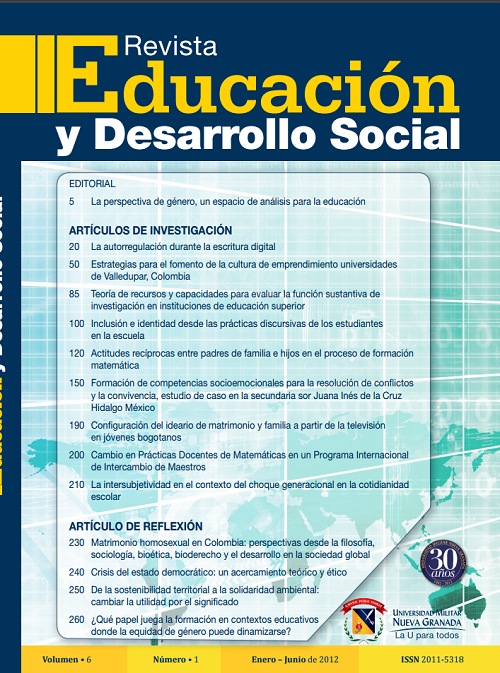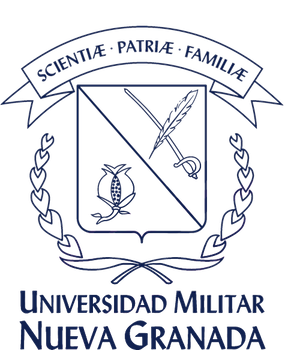Theory of resources and capabilities to assess the substantive role of reserach in higher education institutions
Abstract
This article aims at using the theory of resources and capacities for assessing the substantive role of research in Colombian universities. It is a result of a research conducted in a private university in the city of Manizales, Colombia, where this approach is applied based on intellectual capital involving human, structural and relational capital. The measurement of the researchers’ profile and the characterization of research groups are relevant issues for human capital. The organizational culture, innovation, technological infrastructure; project management and products of science, technology and innovation are essential in the structural capital. The relational capital integrates communities
and networks, inter-institutional cooperation and the relationship among University, Enterprise, State and Civil Society. The main conclusion of this study is the ability to manage intellectual capital in higher education institutions to strengthen Science, Technology and Innovation CTI within the framework of knowledge management and to measure results and impacts of the research role.
Downloads
References
• AECA. (1998). Los indicadores en la gestión de las entidades públicas. Comisión de Contabilidad de Gestión. Madrid: AECA.
• Alles, M. (2003). Dirección estratégica de recursos humanos. Gestión por competencias. Buenos Aires.: Ediciones Granica.
• Alvesson, M. (2004). Knowledge Work and Knowledge-Intensive Firms. New York: Oxford University Press.
• Arbonies, A. (2007). ¿Innovación o Evolución? España.: Díaz de Santos.
• Arboníes, A. L. (2006). Conocimiento para innovar. ¿Cómo evitar la miopía en la gestión del conocimiento?. Madrid: Díaz de Santos.
• Beckman, T. (1997). A methodology for knowledge management. En I. A. Development (Ed.), AI and Soft Computing Conference. Banff, Canada: IASTED.
• Bontis, S. (1996). There´s a price on your head: managing intellectual capital strategically. Business Quarterly., 60, 41-47.
• Brooking, A. (1996). El capital Intelectual: El principio activo de las empresas del tercer milenio. Editorial Paidós Ibérica S.A.
• Bueno, E. (1998). El capital intangible como clave estratégica en la competencia actual. Boletín de Estudios Económicos, 53, 207-229 y Sistemas AECA.
• Bueno, E., Morcillo, P., & Salmador, M. P. (2006). Dirección estratégica. Nuevas perspectivas teóricas. Madrid: Pirámide.
• Camisón, C., Palacios, D., & Devece, C. (1998). Un nuevo modelo para la medición del capital intelectual: el modelo Nova. Ponencia presentada al X Congreso de ACEDE. Oviedo.: ACEDE.
• Carballo, R. (2004). En la Espiral de la Innovación. España.: Díaz de Santos.
• Carmeli, A. (2004). The link between organizational elements, perceived external prestige and performance. Corporate Reputation Review. 6, 314-331.
• Carmeli, A., & Tishler, A. (2004). The relationships between intangible organizational elements and organizational performance. Strategic Mangement Journal. 25, 1257-1278.
• Castelo, E. (2002). Los activos intangibles en la Era del Conocimiento. Boletín de Estudios Económicos, LVII(176), 197-226.
• Centro de Investigación sobre la Sociedad del Conocimiento. CIC. (2003). Modelo Intellectus: medición y gestión del capital intelectual. Madrid: Universidad
• Cheng, J., Zhu, Z., & Yuan, H. (2004). Measuring intellectual capital: a new model and empirical study. Journal of Intellectual Capital., 5, 195-212.
• COLCIENCIAS. (2008). Colombia Construye y Siembra Futuro. Política Nacional de Fomento a la Investigación y la Innovación. Bogotá: COLCIENCIAS.
• COLCIENCIAS. (2013). Modelo de medición de grupos de investigación, desarrollo tecnológico y/o de innovación. Bogotá: COLCIENCIAS.
• Congreso de Colombia. (2009). Ley 1286. Por la cual se modifica la Ley 29 de 1990, se transforma a Colciencias en Departamento Administrativo, se fortalece el Sistema Nacional de Ciencia, Tecnología e Innovación en Colombia y se dictan otras disposiciones. Bogotá: Congreso de Colombia.
• Conner, K. R., & Prahalad, C. K. (1996). A resource-based theory of the firm: Knowledge versus opportunism. Organization Science, 7(5), 477-501.
• Danskin, P., Englis, B., Solomon, M., Goldsmith, M., & Davey, J. (2005). Knowledge management as a competitive advantege: lessons from the textile and apparel value chain. Journal of Knowledge Management., 9(2), 91-102.
• Davenport, T. (2000). Capital humano: creando ventajas competitivs a través de las personas. Madrid: Gestión 2000.
• Departamento Nacional de Planeación. (2008). Documentos CONPES 3527. Política Nacional de Competitividad y Productividad. Bogotá, D.C.: DNP.
• Departamento Nacional de Planeación. (2009). Documento CONPES 3582. Política Nacional de Ciencia, Tecnología e Innovación. Bogotá: DNP.
• Departamento Nacional de Planeación. (2009). Política Nacional de Ciencia, Tecnología e Innovación. Documento Conpes 3582. Bogotá: DNP.
• DNP. (2008). Política Nacional de Competitividad y Productividad. Documento CONPES 3527. Bogotá: CONPES.
• Drucker, P. (2001, Noviembre 3). The Next Society. The Economist, 3-22.
• Easterby-Smith, M., Crossan, M., & Nicolini, D. (2000). Organizational learning: debates past, present and future. Journal of Management Studies., 37(6), 783-796.
• Edvinsson, L., & Malone, M. S. (1998). El Capital Intelectual. Cómo identificar y calcular el valor inexplotado de los recursos intangibles de su empresa. Bogotá.: Editorial Norma.
• Fernández, J. (2005). Gestión por competencias. Un modelo estratégico para la gestión de recursos humanos. Madrid: Pearson Educación.
• Gallego, I., & Rodríguez, L. (2005). Situation on intangibles assets in spanish firms: an empirical analysis. Journal of Intellectual Capital., 6, 105-126.
• Garavan, T. N., Gunigle, P., & Morley, M. (2000). Contemporary HRD Research: A triarchy of theoretical perspectives and their prescriptions for HRD. Journal of European Industrial Training, 24(2), 65-93.
• Gloet, M., & Berrell, M. (2003). The dual paradigm nature of knowledge management: implications for achieving quality outcomes in human resource management. Journal of Knowledge Management, 7(1), 78-89.
• Gómez -Mejía, L. R., Balkin, D. B., & Cardy, R. L. (2001). Gestión de Recursos Humanos. (3a ed.). Madrid: Prentice Hall.
• Gómez, A., & Calvo, J. L. (2011). INNOVACIÓN: Factor Clave del Éxito Empresarial. Bogotá., Colombia.: ECOE Ediciones.
• Grant, R. M. (1996). Prospering in Dinamically-Competitive Environments: Organizational Capability as knowledge integration. Organization Science, 7(4), 375-387.
• Hitt, M., Bierman, L., Shimizu, K., & Kochhar, R. (2001). Direct and moderating effects on human capital on strategy and performance in professional service firms: a resourced-based perspective. Academy of Management Journal., 44, 13-28.
• Holsapple, C., & Joshi, K. (1998). Knowledge management: a three-fold framework. Kentucky initiative for knowledge Management. Research Paper No. 118.
• Huselid, M. (1995). The impact of human resource management practices on turnover, productivity and corporate financial performance. Academy of Management Journal., 38, 635-672.
• I.U. Euroforum Escorial. (1998). Medición del captial intelectual: modelo intelect. Madrid: I.U. Euroforum Escorial.
• Joyanes, L. (1997). Cibersociedad. Los Retos Sociales ante un nuevo mundo digital. Madrid: McGraw-Hill.
• Keong, K. (2008). Intellectual capital: definitions, categorization and reporting models. Journal of Intellectual Capital., 9(4), 609-638.
• Marquardt, M. J. (1996). Building the learning organization, a systems approach to quantum improvement and global success. United States of America: McGraw-Hill. Universidad Autónoma.
• Mayo, A., & Lank, E. (2000). Las organizaicones que aprenden (The power of learning). Barcelona: Gestión 2000.
• Meisinger, S. (2006, Mayo). Talent Management in a Knowledge-Based Economy. HR Magazine, 51(5), 10.
• Narasimha, S. (2000). Organizational knowledge, human resource management and sustained competitive advantage: Toward a framework. Competitiveness Review, 10(1), 123-135.
• Navas, J. E., & Ortíz de Urbina, M. (2002). El capital intelectual en la empresa: análisis de criterios y clasificación multidimensional. Economía Industrial(346), 163-171.
• Nonaka, I., & Takeuchi, H. (1995). The Knowledge Creating Company: How Japanese Industries Create the Dynamics of Innovation. New York: Oxford University Press.
• Observatorio Colombiano de Ciencia y Tecnología OCyT. (2011). Indicadores de Ciencia y Tecnología 2011. Bogotá: Panamericana formas e Impresos.
• OCDE & Eurostat. (2005). Manual de Oslo, Guía para la recogida e interpretación de datos sobre innovación. Oslo: Organización de Cooperaicón y Desarrollo Económico OCDE. Oficina de Estadísticas Comunidad Europea.
• OCDE. (2014.). Estudio de la OCDE de las políticas de innovación. OCDE.
• Ordoñez de Pablos, P. (2004). Measuring and reporting structural capital: lessons from European learning firms. Journal of Intellectual Capital., 5, 629-647.
• Ortíz, E., & Nagles, N. (2008). Gestión de Tecnología e Innovación, Teoría, procesos y práctica. Bogotá.: Universidad EAN.
• Porter, M. E. (1982). Estrategia Competitiva. México.: CECSA.
• Prahalad, C., & Ramaswamy, V. (2004). El Futuro de la Competencia. España.: Ediciones Gestión 2000.
• Puchol, L. (2003). Dirección y Gestión de recursos Humanos. Madrid: Díaz de Santos.
• Quinn, & Hilmer. (1994). Strategic Outsourcing. Sloan Management REview., 20(1), 7-21.
• Quinn, J. B. (1992). Intelligent Enterprise: A Knowledge and Service Based Based Paradigm for Industry. New York: The Free Press.
• Riesco, M. (2006). El negocio es el Conocimiento. Madrid: Díaz de Santos.
• Ruggles, R. (1997). Knoledge mangement tools. Washington: Butterworth Heinemann.
• Saint-Onge, H. (1996). Tacit knowledge: the key to strategic alignment of intellectual capital. Strategy and Leadership., 24(2), 10-14.
• Senge, P. (2012). La quinta discplina. Barcelona: Granica.
• Spender, J. C. (1996). Organizational Knowledge, learning and memory: three concepts in search of a theory. Journal of Organizational Change Management, 9, 63-79.
• Starbuck, W. H. (1992). Learning by knowledge-intensive firms. Journal of Management Studies, 29(6), 713-740.
• Steward, T. (1997). Intellectual Capital. Nueva York.: Doubleday.
• Subramanian, M., & Youndt, M. (2005). The influence of intellectual capital on the types of innovative capabilities. Academy of Management Journal., 48, 450-463.
• Sveiby, K. (1997). The new organizational wealth. San Francisco.: Berret-Koehler Publisher Inc.
• Tippins, M., & Sohi, R. (2003). It competency and firm performance: is organizational learning a missing link? Strategic Management Journal., 24(8), 745-761.
• UNESCO-CIUC. (1999). Declaración de Budapest. Declaración sobre la Ciencia y el uso del saber científico, Conferencia Mundial sobre la Ciencia para el siglo XXI: Un nuevo compromiso, Budapest.
• Valle, R. J. (2004). La Gestión Estratégica de los REcursos Humanos. Madrid: Pearson Educación.
• Valsameda, O., & Hernández, N. (2012). Fuentes de conocimiento en los procesos de innovación empresarial: Las Spin-Off universitarias en Andalucía. ARBOR Ciencia, Pensamiento y Cultura., 188(763), 211-228.
• Varela, C. (2008, Febrero). Gestión del conocimiento, aprendizaje organizativo y capital intelectual. Capital Humano(218), 72-77.
• Viedma, J. M. (2001). Innovation Intellectual capital benchmarking system. Congreso Mundial sobre capital intelectual. Hamilton, Canadá: Mc Master University.
• Warn, J. (2005). Intangibles in commercialisation: the case of air navigation services in the south pacific. Journal of Intellectual capital., 6, 72-88.
• Wiig, K. M. (1993). Knowledge management foundations: thinking about thinking-how people and organizations create, represent and use knowledge. Texas: Schema Press:Arlington.
• Wilcox, A., Fowler, S., & Zeithaml, C. (2001). Managing organizational competencies for competitive advantage: the middle-management edge. The Academy of Management Executive., 15, 95-106.
• Youndt, M., & Snell, S. (2004). Human resource configurations, intellectual capital and organizational performnce. Journal of Management Studies., 42, 335-361.
• Youndt, M., Subramanian, M., & Snell, S. (2004). Intellectual capital profiles: an examination of investments and returns. Journal of Management Studies., 42, 335-361.













